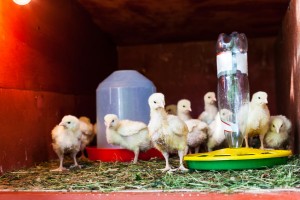There will come a day when your chicks are ready to leave the nest…or rather, the brooder. Moving your chicks from the brooder to the coop is a significant change, and it’s one that will come with some serious adjustments for you, your chicks, and the rest of your flock. It’s best to make this transition slowly instead of forcing your chicks into the coop all at once.
Are your chicks old enough to leave their brooder? Then here are some tips on how to transition your chicks from the brooder to the coop smoothly: 
When to start the transition
The exact time that you begin to ease your young chickens into the coop will depend on them. In general, though, you will want to wait until your chicks are fully feathered. This places the transition anywhere between 6 to 7 weeks of age, although if they are an entirely new flock, they can transition over earlier than 6 weeks.
Acclimate them to lower temperatures
In your chicks’ first week of life, the brooder should be kept at around 90 to 95 degrees Fahrenheit. You should decrease this temperature by 5 degrees each week. That way, by 6-7 weeks of age your chickens will be able to regulate their own temperature.
Make your coop accessible to younger chickens
Before you bring your chicks into the coop, check to make sure that it’s ready to receive younger chickens. Your chicks will be smaller than your adults, so hanging feeders, nipple drippers, and perches may be too high for them to reach. Ensure that you install these features at the proper height for your young chicks, and if your coop itself is elevated, place a ramp outside so that they can access the door.
Ease them into the coop
When it’s finally time to move your young chickens into the coop, make the transition a slow and gentle one. First, take your chicks outside into the run (ensuring, of course, that it is entirely secure, and they’re supervised at all times). Keep them outside for about an hour on the first day, then return them to the brooder. Increase the amount of time they spend out in the run each day until they’re able to stay out for around 5 to 6 hours. After that, open the door to the coop and let your chicks wander in on their own. If all goes well, move their feeder and waterer into the coop, but still leave the brooder available for them to sleep in. As your chicks become more comfortable, they’ll eventually begin sleeping inside the coop on their own.
Keep them separate from older chickens until they’re fully grown
On that first day when you introduce your chicks to the outside world, don’t place them in the same run as your adult chickens. Forcing your chicks and older chickens to interact too soon can cause bullying, fighting, and even disease. Instead, create a separate run for your chicks right alongside the one for your adult chickens. This will allow them to get used to one another in a safe environment. If there are no incidents after the first week, you can begin slowly introducing your chicks to the rest of the flock.
To learn more about how to transition your young chickens from the brooder to the coop, read through our blog, or contact Chickens for Backyards today!

